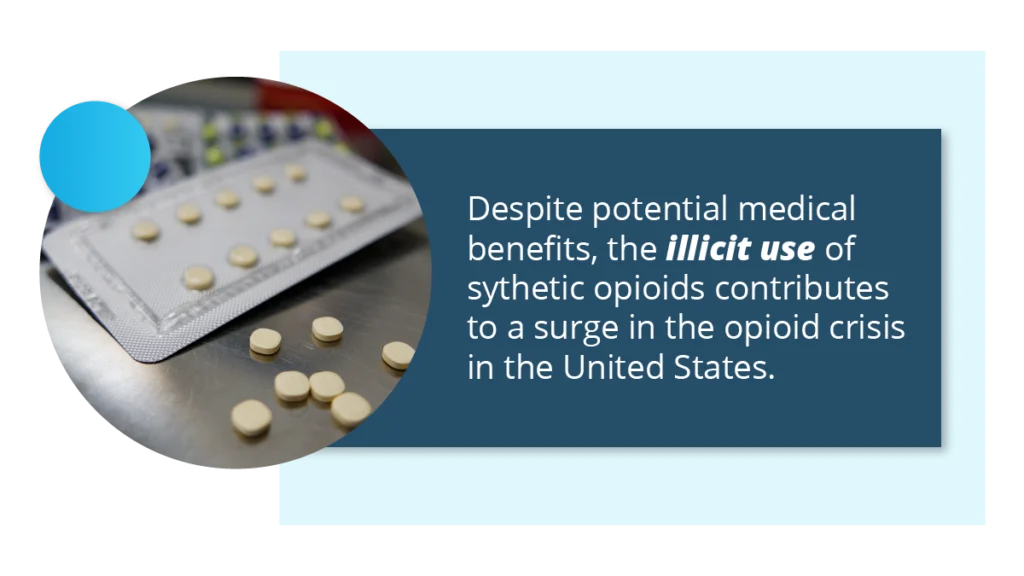Synthetic opioids are artificial drugs designed to mimic the effects of natural opioids like heroin and morphine. Examples include fentanyl and carfentanil. These drugs bind to the same brain receptors as natural opioids, but they are much more robust, leading to a higher risk of overdose.
Their danger lies in potency, as even a tiny amount can be lethal. They’re often mixed with other drugs, increasing the peril. Synthetic opioids contribute significantly to the opioid crisis in the United States, causing a surge in overdose deaths.
Key Takeaways
Opioids are powerful pain-relieving medications, both natural and synthetic. Here’s what you need to know:
- Despite potential medical benefits, their illicit use contributes to a surge in the opioid crisis in the United States.
- Notable examples include Fentanyl, Carfentanil, Methadone, and Tramadol.
- It is crucial to recognize the importance of promoting widespread awareness and safe practices for the use of opioids.
The Haven Detox-Little Rock offers a supportive environment for individuals seeking recovery from substance abuse. Contact us at (501) 271-3342 for more information.
Opioids Explained
Opioids are powerful pain-relieving medications, both natural and synthetic. They work by tying to specific receptors in the brain, reducing pain perception. Common examples include oxycodone and morphine. While they’re beneficial for managing pain, misuse can lead to severe problems.
Prescription opioids can be addictive, and misuse may result in overdose. The United States faces an opioid crisis marked by a surge in opioid-related deaths. Heroin, an illegal opioid, contributes to this crisis.
Additionally, synthetic opioids like fentanyl pose a significant threat due to their potency. People of all demographics need to understand the safe use of opioids, the potential risks, and how to recognize signs of overdose.
History of Synthetic Opioids
In the mid-20th century, the quest for effective pain relief led to the creation of synthetic opioids. Early milestones, like the development of methadone and fentanyl, set the stage for both medical progress and challenges. Learning this history is vital to navigating the complex landscape of synthetic opioids in the United States.
Early Developments
Chemists developed synthetic opioids as new pain relievers. Methadone, set in the 1940s, was initially used to treat pain and later became a tool for managing opioid addiction.
The 1960s saw the arrival of fentanyl, designed for medical settings due to its potency. However, these early developments paved the way for later challenges, as synthetic opioids became not just a medical asset but a significant factor in the opioid crisis.
Modern Advancements
In recent decades, new synthetic opioids have emerged, aiming to address pain more effectively. Substances like carfentanil, designed for large animals, and U-47700, initially a research chemical, exemplify modern advancements.
Despite potential medical benefits, their illicit use contributes to a surge in opioid-related deaths in the United States. The evolution of synthetic opioids underscores the importance of vigilant regulation to mitigate their adverse effects.
Examples of Synthetic Opioids
Synthetic opioids, engineered in laboratories, have become a concerning facet of the opioid epidemic. Notable examples include fentanyl, carfentanil, and U-47700, each surpassing the potency of natural opioids, contributing to heightened overdose risks and complicating addiction challenges.
Fentanyl
Fentanyl, a potent synthetic opioid, is 50 to 100 times stronger than morphine. Initially used medically for severe pain, its illicit variants flood the illegal drug market. Its potency poses a high risk of overdose, leading significantly to the opioid crisis in the United States.
Law enforcement faces challenges due to its prevalence and involvement in fatal overdoses. Increased awareness, strict regulation, and harm reduction efforts are crucial in addressing the impact of fentanyl on public health.
Methadone
Developed in the 1940s, methadone, a synthetic opioid, aimed initially to treat pain. Its role expanded to opioid addiction treatment due to its long-lasting effects, suppressing withdrawal symptoms. While effective, its potential for misuse and overdose necessitates careful management in opioid maintenance programs.
Despite benefits, there’s a delicate balance between therapeutic use and minimizing the risk of dependency. Strict medical supervision, tailored dosages, and comprehensive patient education are key components of responsible methadone use.
Tramadol
Tramadol, a synthetic opioid with weaker effects than traditional opioids, gained popularity as a pain reliever. Initially perceived as having a lower risk of abuse, it was classified as a Schedule IV controlled substance. However, reports of misuse and dependence prompted closer scrutiny. Tramadol‘s unique dual mechanism raises concerns about its potential for seizures and serotonin syndrome.
Striking a balance between pain management and minimizing adverse effects remains a medical challenge. It emphasizes the importance of informed prescribing and vigilant monitoring.
Carfentanil
Carfentanil, an extremely potent synthetic opioid, is approximately a hundred times more powerful than fentanyl. Initially designed for large animals, its illegal use poses severe dangers to humans due to its strength.
Carfentanil has been linked to numerous overdose deaths, highlighting the urgent need for public awareness and stringent law enforcement measures.
Its secret production and presence in illicit drug supplies underscore the complexity of combating its impact on the opioid crisis. Addressing the threat of carfentanil requires a multifaceted approach, including targeted interventions, regulation, and community education.
Synthetic Opioids and the Opioid Crisis
Synthetic opioids play a pivotal role in the opioid crisis gripping the United States. These lab-made substances, like fentanyl and its analogs, are potent and often illicitly manufactured, contributing to the surge in opioid-related deaths. Unlike naturally occurring opioids, such as morphine, synthetic opioids are created in labs, allowing for variations in strength and composition.
Their high potency poses a significant danger, with even small amounts leading to overdose. Illicitly produced synthetic opioids frequently find their way into the illegal drug market, often mixed with other substances like heroin or counterfeit pills. Unaware of the potent content, individuals may unknowingly ingest these lethal combinations.
The opioid crisis is exacerbated by the ease of production and distribution of synthetic opioids, making them a cheap alternative for drug traffickers. These substances have overwhelmed healthcare systems and law enforcement, requiring specialized treatment and detection methods.
Dangers and Risks of Synthetic Opioids

With potency levels far exceeding traditional opioids, these synthetic variants significantly elevate the risks of addiction, overdose, and fatalities. The situation requires immediate attention and a thorough approach to prevent further issues.
Overdose and Death
The use of synthetic opioids, such as fentanyl, poses a severe risk of overdose and death. These substances are exceptionally potent, even in tiny amounts, making accidental overdose familiar. Individuals may experience difficulty breathing, loss of consciousness, and, in extreme cases, death. Prompt medical attention is crucial in overdose situations, emphasizing the urgency of recognizing symptoms and seeking help immediately.
Addiction and Dependence
Synthetic opioids can lead to addiction and dependence. Regular use alters the brain’s chemistry, creating a strong desire to continue using these substances. Over time, individuals may find it challenging to stop without experiencing withdrawal symptoms like nausea, muscle pain, and anxiety. Early identifying the signs of addiction is vital for seeking appropriate interventions and support.
Physical and Mental Health Risks
The use of synthetic opioids poses significant physical and mental health risks. Physically, these substances can cause respiratory issues, heart problems, and damage to vital organs. Mentally, they may contribute to anxiety, depression, and cognitive impairment. Seeking comprehensive healthcare, including mental health support, is crucial for individuals using or recovering from synthetic opioid use to address both immediate and long-term health concerns.
Synthetic Opioid Abuse
The rise in synthetic opioid abuse, exemplified by substances like fentanyl, presents a grave public health concern. These potent drugs pose a heightened risk of addiction and overdose.
Addressing synthetic opioid abuse demands a multifaceted approach, encompassing prevention, treatment, and harm reduction strategies to mitigate the devastating impact on individuals and communities.
Identifying the Signs
Identifying synthetic opioid abuse involves observing behavioral and physical changes. Look for signs like sudden mood swings, social withdrawal, and neglect of responsibilities. Physical indicators may include changes in sleep patterns, pinpoint pupils, and unexplained weight loss.
Prevention Strategies
Preventing synthetic opioid abuse involves raising awareness and implementing community-based strategies. Education on the dangers of these substances, proper medication disposal, and the rise of alternatives for pain management are required.
Additionally, access to mental health resources and support services can address underlying issues contributing to substance abuse. Community involvement and vigilant monitoring of prescription medications play key roles in prevention efforts.
Addiction Treatment for Synthetic Opioids
Treatment for synthetic opioids, such as fentanyl, requires a thorough approach to address the complex nature of addiction.
Detoxification (Detox): The initial step involves medically supervised detox to manage withdrawal symptoms safely. This process is vital for clearing the body of opioids while minimizing discomfort.
Inpatient Rehabilitation: Inpatient treatment provides a structured environment where individuals receive intensive therapy and support. This setting allows for 24/7 medical supervision, counseling, and access to various therapeutic modalities.
Outpatient Programs: After inpatient rehabilitation, transitioning to outpatient programs helps individuals reintegrate into daily life while continuing therapy. Outpatient care allows individuals to attend treatment sessions while maintaining their responsibilities.
Medication-Assisted Treatment (MAT): Some may benefit from MAT, combining medications like buprenorphine or methadone with counseling and behavioral therapies to manage cravings and withdrawal symptoms.
Counseling and Therapy: Behavioral therapies, such as cognitive behavioral therapy (CBT) and contingency management, play a vital role in addressing the psychological aspects of addiction and developing coping mechanisms.
A personalized treatment plan considering the severity of addiction, individual needs, and ongoing support is essential for combating synthetic opioid addiction effectively.
Frequently Asked Questions (FAQ)
What are synthetic opioids, and how are they different from naturally occurring opioids?
In recent years, synthetic opioids have emerged as a concerning category of narcotic drugs, including fentanyl analogs. Unlike natural opiates derived from opium poppies, new opioids are often produced in labs by pharmaceutical companies.
Patients prescribed synthetic opioids may develop tolerance, leading to respiratory depression and a raised risk of overdose. Illicit fentanyl, involved in many drug overdose deaths, is a potent synthetic opioid.
Naloxone, a medication, can reverse opioid overdose effects. The CDC studies substance use disorders, stressing the impact of synthetic drugs like fentanyl and its analogs. The opioid crisis involves not only heroin but also synthetic opioids present in street drugs and pharmaceutical formulations.
What does a synthetic opioid mean?
A synthetic opioid is an artificial drug produced in a lab rather than occurring naturally. These drugs, like fentanyl, are designed to mimic the effects of natural opiates. They are potent pain relievers, but misuse can lead to severe health crises, including respiratory problems and overdose. Doctors prescribe some synthetic opioids, while others, like illicit fentanyl, can be found in street drugs.
Is fentanyl manufactured synthetically?
Fentanyl is a synthetic opioid that is created in a laboratory and not derived from natural sources like opium. It is a potent pain reliever, much stronger than other opioids such as morphine or heroin. However, illicitly produced fentanyl is highly dangerous and can cause overdose due to its potency.
In the United States, it is often mixed with other drugs, leading to unintentional overdoses. The strength of fentanyl increases the risk of harm, making it crucial to handle any medications containing fentanyl with caution and awareness. Understanding the synthetic nature of fentanyl is essential to mitigate potential hazards and promote safe usage.
The Haven Detox-Little Rock: Gateway to Recovery
At The Haven Detox-Little Rock, we stand with you against addiction, whether it’s rooted in alcohol or drugs. Our team uses a compassionate approach to guide individuals to lasting recovery.
We offer various services to address multiple facets of the recovery process. Our specialized opioid treatment integrates targeted medications to mitigate dependency. During the detox program, our expert team ensures a secure withdrawal with a focus on individual needs.
The residential program provides a supportive haven for intensive recovery, nurturing a holistic healing environment. Start your journey on the road to lasting change. Contact us at (501) 271-3342 today and pave the way to recovery.





